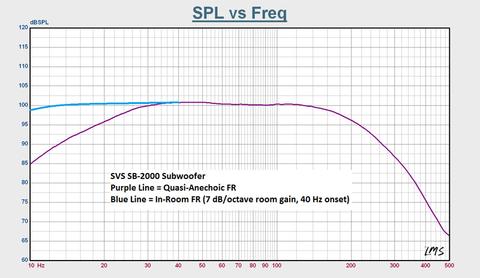Esa es una simulación room gain + DSP del sub. Por cierto, es muy posible que acabe comprando un par de estos para la nueva sala.
Aquí también se habla de la ganancia de sala:
Results Based on our testing, the effects of taking the subwoofer into the room
results in very large changes in the response that arrives at the listening position. Looking at both the main position response and the total average response change,
it is easy to see that generalizations or simulated guesses as to the amount of room gain are likely to be far off and can vary wildly with frequency.
For example, this room provides a decent amount of average gain between about 2-4dB from 190Hz until about 50Hz in both the main position average and the total 6 position average before exhibiting a huge spike between 40 and 50Hz which is related to the room�s worst resonance. However, at 30Hz there is an average loss of 4dB. Between 15 and 26Hz we again see a nice boost of about 7 or 8 dB on average but at 12Hz there is no net gain or actually a small loss before rebounding to about +7dB at 10Hz. From there, the gain skyrockets into the single digits.
https://www.data-bass.com/data?page=content&id=80
La ganancia de sala es un hecho no se puede negar, pero depende de muchos factores y no todas las salas son iguales.
Además hay que considerar la distancia del sun al punto de escucha que en salas grandes seguramente va a ser mucho mayor que la distancia a la que se toman los datos en anecoica.
Many times you will see discussions of how much extra SPL a subwoofer will gain by being placed into a room, a corner, a vehicle, or a 1/8th, 1/4th or 1/2 space environment rather than a full space or anechoic equivalent. There are often times
assumptions made about when and where gain takes place in a "typical" space and by how much. These assumptions are used to make educated guesses during system design or when evaluating what the response will be or what SPL levels the system might be capable of.
You may have also seen simulations of subwoofer systems inside of enclosure modeling programs where the distance to the system or the environment that the system is operating in can be simulated as well. For example, a proposed system might be
simulated at a 3 meter distance or placed into an eighth space environment and an assumption is made about the
real space frequency response or output headroom based on this.
There are a few major errors in judgment commonly seen in these speculations:
- Not accounting for the distance to the listening position from the subwoofer. Most system models are positioned one meter from the subwoofer, however, most listeners do not sit this close.
- Not accounting for the construction of the space the subwoofer will be placed in.
- Not accounting for other objects that may be close by.
Other things to consider are the
volume, dimensions and shape of the space which also can have significant impact. There are programs that will help estimate the basic acoustics of a square or rectangular room but they only cover the most simple of spaces and parameters. In light of all this speculation, we decided to do a simple investigation on the effects of placing a basic subwoofer into an example of a fairly typical or average construction, shape and size room.




 LinkBack URL
LinkBack URL About LinkBacks
About LinkBacks


 Citar
Citar
